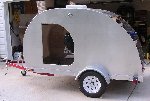bdosborn wrote:
1) My opinion is that the trailer frame absolutely should be grounded to shore power. If for some reason the hot wire energizes the trailer frame, you want a path to conduct the current to ground (and pop the breaker). I don't want to be that path, which is what I would be if I touched it and the frame isn't grounded through the shore power ground. Since I'm a fairly high impedance path to ground, the breaker may not pop and the end result is barbeque Bruce. I may be tasty but I'm not that generous. So I'll ground the shore power plug(s) and the frame (as soon as I finish the stupid galley). If I were skinning with aluminum I'd ground that too.
Hi Bruce,
You may be right... I'm open for discussion... Lets walk through the logic...
For discussions sake lets assume no trailer circuit breakers or GFCIs are installed (insanity!) and the only ground available is an 8' rod in the ground from shore power.
120VAC Frame GroundedYou ground the 120VAC to the trailer frame. You then have a short from the 120VAC hot line directly to frame ground. What circuit completes the path from frame ground to shore power ground? Hopefully your extension cord and the camp site wiring circuit.
As noted above, if you are tying the trailer frame to the shore power ground, you are counting on the shore power ground integrity to be intact. And even if it is intact you can fry (this possibility based on the first article you referenced). (hopefully you pop the shore power CB before doing terminal damage)
Now lets go the other way...
120VAC with no frame groundYou run 120VAC utilizing only the shore power ground. You then have a short from the 120VAC hot line directly to frame ground. What circuit completes the path from frame ground to shore power ground?
Answer, The trailer frame is not grounded to anything so a possibility of up to 120VAC difference of potential exists from the trailer frame to shore power ground. You touch the trailer frame and you complete the circuit and fry.
In both cases you are counting on the shore power ground integrity to be intact. If it fails you fry. (again, hopefully you pop the shore power CB)
Remember electricity seeks the path of least resistance which <should> always be shore power ground but based on your first article, resistance can grow enough to cause a difference of potential by as much as 100VAC in as little as 3-5 ft from the ground rod. Even at 1 ft the picture illustrates the possibility of an 80VAC difference of potential! How many tears are located 1ft from the ground rod? I'm showing just the image from the article you referenced in Mike Holtz Enterprizes site to illustrate the point I'm trying to make.
 Now add in circuit breakers and GFCIs to either scenario...
Now add in circuit breakers and GFCIs to either scenario...If one installs a circuit breaker and a GFCI in ones trailer, you protect both the wiring(CB), and the individual(GFCI) with or without grounding to the frame.
A quote from How Stuff Works regarding GFCIs...
"One of the newer circuit breaker devices is the ground fault circuit interrupter, or GFCI. These sophisticated breakers are designed to protect people from electrical shock, rather than prevent damage to a building's wiring. The GFCI constantly monitors the current in a circuit's neutral wire and hot wire. When everything is working correctly, the current in both wires should be exactly the same. As soon as the hot wire connects directly to ground (if somebody accidentally touches the hot wire, for example), the current level surges in the hot wire, but not in the neutral wire. The GFCI breaks the circuit as soon as this happens, preventing electrocution. Since it doesn't have to wait for current to climb to unsafe levels, the GFCI reacts much more quickly than a conventional breaker."
I'm counting on good basic wiring, and GFCIs and CBs to protect me. If I have this wrong I need folks brighter then me to tell me so...
The first article clearly shows that counting on shore ground is not viable and supports my (and many others) suggested use of GFCIs. The ground rod will most likely be at the nearest utility pole which could be many feet away from our teardrops.
The other articles are sad but my tear isn't a houseboat sitting in a fresh water lake with rigged electrical wiring. I'm not sure the pool house had GFCIs installed. The article did say all electrical connections in the building were up to code. They fixed the problem by placing rubber mats under the machines large enough to isolate the users while using the machine and repairing the defective power cord.
Regarding my Inverter
I am not real clear about the inverter tab ground.... shore power ground seems unlikely as it is used to provide 120VAC from a completely disconnected system running on 12VDC.
My instructions are not clear and that is why I asked. It clearly is a inverter chassis ground tab.
Any and all insight on anything here would be very much appreciated.










 I don't remember seeing any of them
I don't remember seeing any of them  , but will definitely go back and look again.
, but will definitely go back and look again.